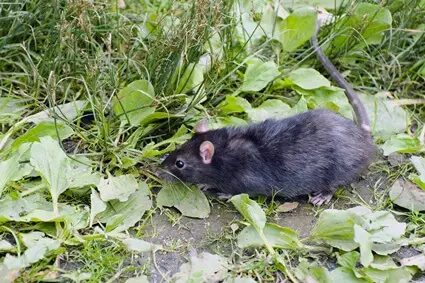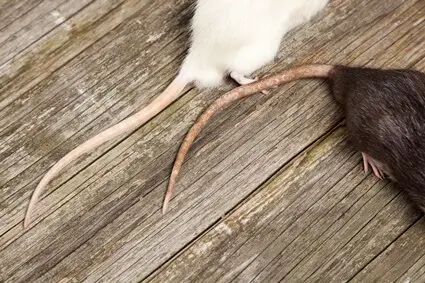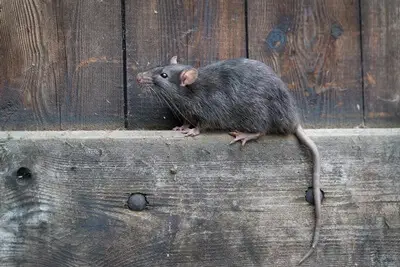One of the most distinguishing features of rats is their long, hairless tails.
Such a lengthy appendage may seem inconvenient for rats since it makes them an easy catch for predators. However, rats’ tails are a crucial part of their anatomy.
The tail allows them to stay cool, remain warm, and maintain balance.
Rats can’t regrow their tails, but they can live without them if they are amputated. Rats born without tails often die at a young age because they suffer accidental falls and overheat in high temperatures.
What Do Rats Use Their Tails For?
A rat’s tail is critical to its survival and well-being. Rats use their tails for the following reasons:
Thermoregulation
Rats’ tails function as thermoregulators for their bodies. Unlike humans, rats don’t sweat since their bodies are covered in fur. Instead, they lose their body heat through their tails.
The blood vessels inside a rat’s tail are sensitive to temperature changes and will adjust depending on the rat’s body temperature.
During hot weather, a rat’s body temperature rises steeply. This causes the blood vessels in the rat’s tail to dilate, allowing more blood to flow inside the tail.
The warm blood cools on the surface of the rat’s tail before returning to other parts of the body.
When the weather is cold, the blood vessels inside a rat’s tail constrict, reducing blood flow into the tail. This allows the rat to maintain its body heat.

Balance
Rats’ tails enable them to maintain their balance.
When a rat climbs a rope or walks on a wire, it’ll swing its tail from one side to the next, as needed, to keep its weight centered. This prevents it from losing its balance and falling to its death.
The tail can also work as an anchor, gently wrapping around objects to create a low center of gravity and stop the rat from falling. This allows rats to walk along wires and cables at impressive speeds.
Protection Against Predators
The fact that rats are such small rodents means they have countless predators. Since they have few defense mechanisms, larger creatures prey on them.
Nevertheless, their long tails form part of their survival strategy against threats. Rats use their tails to distract predators by swinging them around.
Most rats would rather lose their tails in an attack than sustain injuries to their main body. After all, they may continue to live when their tails are mauled or severed by a predator.
What Does a Rat’s Tail Look Like?
A rat’s tail is an extension of its vertebral column. The main anatomical components include:
- Bone.
- Skin.
- Tendons.
- Veins.
- Arteries.
The vertebrae (bone) of the tail give it a stiff structure that provides support and balance.
According to SPINE, the thick tendons within a rat’s tail enable the creature to make minor movements while maintaining control of its body.
Moreover, the numerous veins and arteries inside a rat’s tail allow it to expel more than 17% of body heat with 5% of its body surface.
How Long Are Rats Tails?
Most species of rats have tails that are longer than their bodies.
The average rat’s tail grows to 7-10 inches, yet their average body length is 6-8 inches.
Do Rats Have Longer Tails Than Mice?
Rats have longer tails compared to mice.
In contrast to the long tail of a rat, a mouse’s tail will reach 6-8 inches.
Are All Rats Born with Tails?
While most rats are born with tails, there are some rare cases where a rat may be born without a tail.
Usually, this condition is caused by genetic mutations and abnormalities. Most offspring born without tails will survive for a few days or die at birth.
Some rats survive into adulthood without tails, although health problems often beset them. These rats have poor health since their ability to regulate their body temperature and balance is impaired.
Can a Rat Survive Without Its Tail?
Most rats live after getting their tails amputated by predators or losing them in accidents.
While rats can adapt, the absence of a tail has disadvantages, affecting their ability to survive in the wild.
Tailless rats are susceptible to predators because they may not be able to climb raised surfaces. They may be prone to accidental falls because their balance is impaired. Also, they can’t outrun predators.
As mentioned, a vital function of a rat’s tail is to regulate body heat. So, when a rat loses its tail, it won’t be able to lose body heat as effectively as a tailed rat.
The rat’s body temperature would remain high, increasing the risk of heatstroke and organ damage.

Can a Rat’s Tail Grow Back?
Unlike lizards, which can regenerate their tails, rats don’t grow new tails once the original is severed.
A rat’s tail is part of its vertebral column, which doesn’t have regenerative properties. If part of a rat’s tail is injured but hasn’t come away, that section will eventually die and fall off.
The remaining part of the tail will heal and dry up to form a stump
When Does a Rat’s Tail Grow?
Most rats are born with tails that grow while still in their mother’s womb. However, a rat’s tail normally grows only once in its lifetime, so if it gets amputated accidentally or otherwise, it can’t regrow.
According to Gerontology, the chemical composition of a rat’s tail changes as it ages. This means that the tail’s functionality may not be as effective as it was in younger rats.
Why Don’t Rats Have Fur On Their Tails?
While rats have fur on their bodies, their tails are smooth and hairless. The absence of fur on the tail allows rats to regulate their body temperature.
Heat loss would be slower if rats’ tails were covered with fur. However, according to the Journal of Neurophysiology, rats regulate their body heat using their paws, which are also hairless.
Also, hairless tails provide the grip that rats need when latching onto wires or climbing cables. If rats had hairy tails, hanging onto cables without falling off would be more difficult.








